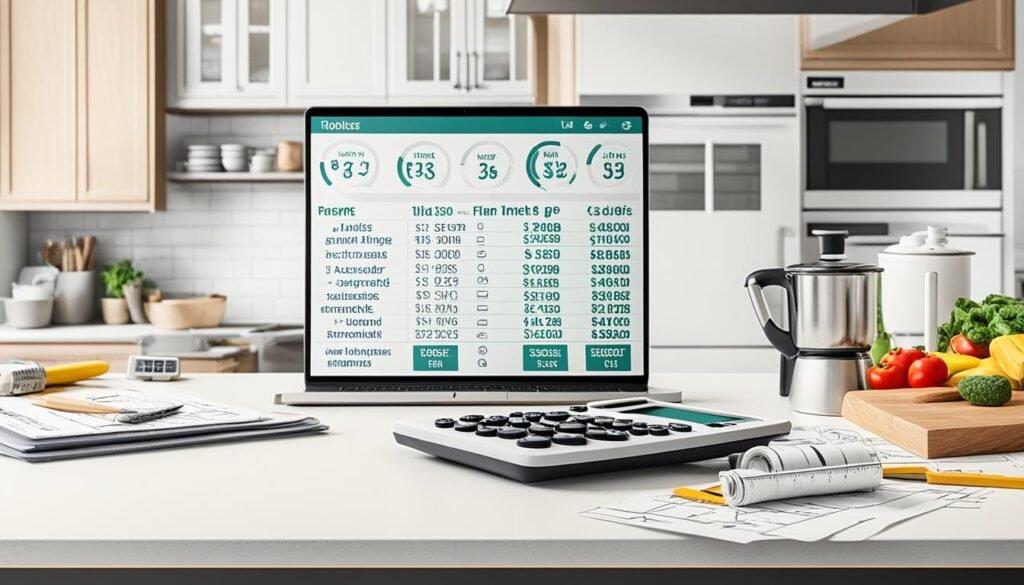Essentials Not to Miss When Remodeling Your Home
Did you know the average American spends about $10,000 on home renovations every year? Remodeling your home is thrilling. It lets you change up your living space to be more useful and beautiful. But, it’s easy to miss some key things during this process. To have a successful renovation, remember some essential factors. In this article, we’ll share a list of essentials for when you remodel your home. This includes practical things to think about, planning and design tips, and the must-have tools. Let’s get started and explore the essential elements for a smooth and successful remodeling journey. Key Takeaways: Consider practical things like hidden outlets and lots of storage. They help make life easier and more organized while remodeling. Good planning and design can save you time, money, and stress. This includes mood boards and asking experts for advice. The right tools, like a strong ladder and quality paint, can make your work better and more efficient. Talking with your design team, doing online research, and checking references are crucial steps. They make sure you hire the best professionals for your job. Remembering these essentials can help you create a space that’s both beautiful and functional. It will meet your needs and make everyday life better. Practical Considerations for Your Remodel Starting a home remodel is exciting. It’s key to think about practical things that improve your daily life. Here are things to keep in mind: Hidden power outlets for charging electronics – Ensure that you have enough power outlets strategically placed throughout your home to conveniently charge your electronic devices. Adequate storage for school bags and sports equipment – Designate storage areas near entryways or in mudrooms to keep school bags and sports equipment organized and easily accessible. Space for ironing board storage – Incorporate a dedicated area for storing your ironing board to keep it out of sight when not in use. Power outlets in the laundry for charging cleaning tools – Install power outlets in your laundry area to conveniently charge cleaning tools such as vacuum cleaners. Drop zone near entry doors for easy organization – Create a designated drop zone near your entry doors to keep keys, wallets, and other daily essentials organized and easily accessible. Coat cupboard for guests – Dedicate a coat cupboard near the entryway for your guests to hang their coats and store their belongings. Sufficient power outlets in strategic locations – Ensure that you have enough power outlets in areas where you’ll need them, such as the kitchen, living room, and home office. Concealing toilets in bathrooms for privacy – Consider incorporating a wall or partition to separate the toilet area from the rest of the bathroom for added privacy. Incorporating a mudroom for storage – If space allows, include a mudroom in your remodel for additional storage and organization. Pull-out bins and recycling systems in the kitchen – Install pull-out bins and recycling systems in your kitchen cabinets to make waste disposal and recycling more convenient. Well-planned lighting for both functionality and ambiance – Plan your lighting design carefully to ensure sufficient task lighting while also creating a welcoming and cozy ambiance. Thoughtful window dressings to maximize natural light – Choose window dressings that allow ample natural light to fill your space while still maintaining privacy and controlling glare. Installation of dimmers for adjustable lighting – Install dimmer switches for your light fixtures to easily adjust the brightness and create different moods in your rooms. Considering the need for water supply to the fridge – If you have a refrigerator with an ice and water dispenser, ensure that you have water supply lines installed to connect it. Concealing TV cables and providing storage for AV equipment – Hide unsightly TV cables and incorporate storage solutions for audiovisual equipment to maintain a clean and organized living space. Installing lights in wardrobes and pantry for convenience – Add lighting fixtures inside wardrobes and pantries to improve visibility and make it easier to find items. Proper shelf height for different items – Adjust the height of shelves in your cabinets and storage areas to accommodate different items, such as tall bottles or small appliances. Avoiding fridge placement next to a wall – Leave enough space between your refrigerator and adjacent walls to ensure proper ventilation and functionality. Adding skylights to brighten up dark spaces – Consider adding skylights to rooms with limited natural light to brighten up the space and create an open and airy feel. Designating multiple living areas for larger families – If you have a large family, designate different living areas within your home to create separate spaces for relaxation and entertainment. Making necessary adjustments for laying new flooring – Before laying new flooring, ensure that the necessary adjustments, such as leveling the subfloor, are made for a smooth installation process. Incorporating power outlets near beds for charging devices – Install power outlets near bedside tables to conveniently charge your devices overnight. Paying attention to the height of sockets above the floor – Place electrical sockets at a suitable height above the floor for easy access and to avoid bending down. Ducting range hood externally for better ventilation – Ensure that your range hood is properly ducted externally to effectively remove cooking odors and smoke from your kitchen. Creating a drying rack in the laundry – Consider incorporating a drying rack or a dedicated space for air-drying clothes in your laundry area. Using underfloor heating for drying room functionality – If you have a dedicated drying room, consider installing underfloor heating to speed up the drying process. Ensuring consistent measurements for tiles and carpet – Pay attention to consistent measurements when laying tiles or installing carpet to achieve a professional and cohesive look. Planning for pet storage and accessories – If you have pets, plan for dedicated storage areas for their accessories, such as leash hooks and feeding stations. Considering door swing and functionality – Take door swing and functionality into account when remodeling to ensure smooth movement
Essentials Not to Miss When Remodeling Your Home Read More »


